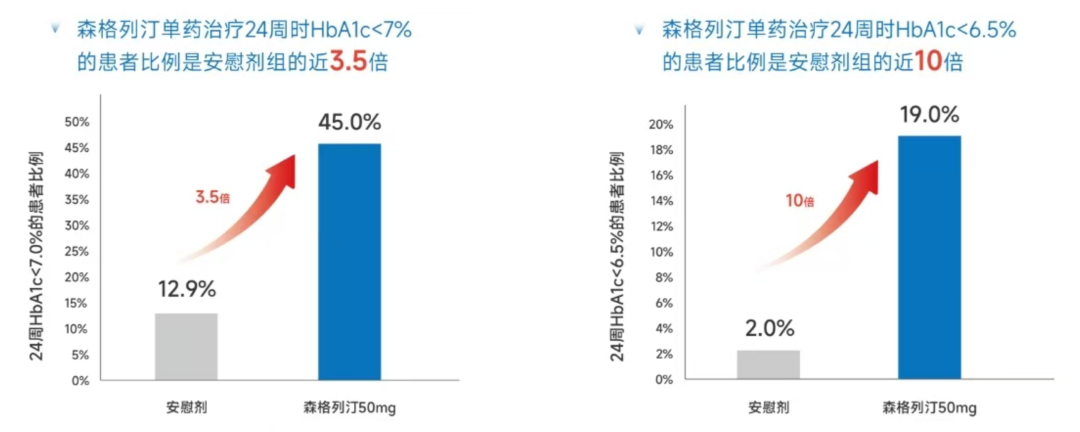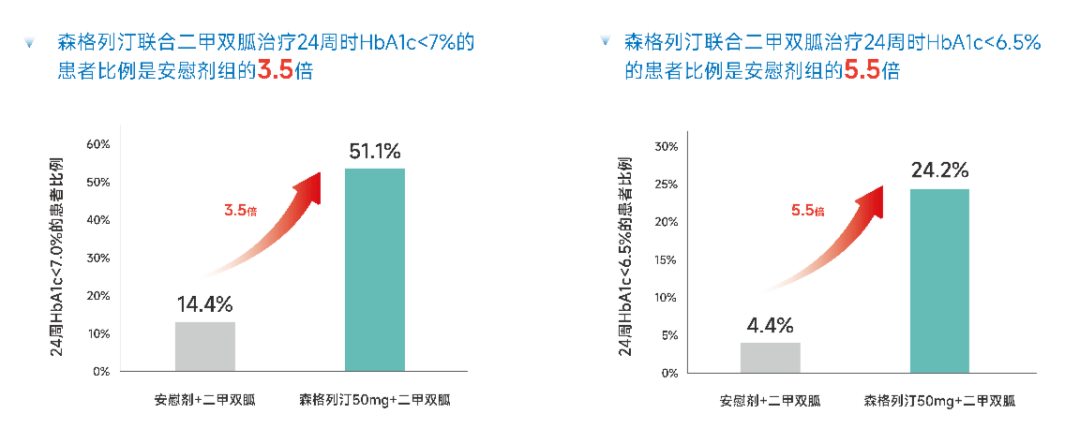Media Focus | Professor Su Qing: Grounded in the Present, Empowered by Innovation—Senglitin Ushers in a New Era of DPP-4 Inhibitor Therapy
Release date:
2025-04-15
Figure 2. HbA1c达标 rate in T2DM patients treated with senglatide monotherapy
"International Diabetes"
Diabetes is one of the major diseases threatening the health of our nation. First, could you please share insights into the current prevalence and management status of diabetes in China?
Professor Su Qing: Over the past two decades, China has conducted extensive epidemiological surveys and research on diabetes, with many of the findings published in leading international journals. This underscores that China’s academic research in diabetes has gained significant global influence. The most recent epidemiological study, carried out jointly by the National Center for Chronic Disease Prevention and Control and the Chinese Center for Disease Control and Prevention from 2018 to 2019, surveyed over 170,000 individuals. The results revealed that, according to the diagnostic criteria set forth by the American Diabetes Association (ADA), the prevalence of diabetes among adults in China stands at 12.4%[1].
The primary factors driving the rising prevalence of diabetes in our country include the accelerated pace of urbanization, an aging population, and the growing prominence of overweight and obesity—ultimately reflecting a profound shift in people's lifestyles. In addition to these, environmental pollution remains a significant concern, as there is a clear link between environmental degradation and the increasing incidence of diabetes. Moreover, modern society is characterized by an increasingly fast-paced lifestyle, leading to heightened stress levels among individuals. This, coupled with rising rates of insomnia, mental health disorders, and other related physical and psychological issues, has further fueled the upward trend in diabetes cases. Although the sharp rise in both the prevalence and number of diabetes cases observed earlier this century has largely been brought under control, the disease continues to inch upward at a gradual pace.
From the perspective of overall diabetes management, while China has achieved some success in curbing the rapid rise of diabetes cases, significant gaps still remain compared to developed Western nations when it comes to key indicators. Currently, the awareness rate of diabetes in China stands at around 36%, with treatment rates falling below one-third and control rates hovering just above 50% [2]. Over the past decade, these metrics have shown only modest improvements, underscoring the urgent need for society as a whole to raise awareness and prioritize diabetes prevention and management. Notably, the Chinese government has officially designated diabetes as one of the four major chronic diseases and has introduced targeted policies to guide efforts in this area. With collective action from all sectors of society, we are confident that we can not only effectively reduce the prevalence of diabetes but also make substantial progress in improving critical indicators such as awareness, treatment adherence, and disease control.
"International Diabetes"
In the field of diabetes treatment, hypoglycemic drugs have been continuously emerging in recent years, offering patients a wider range of options. Among these, DPP-4 inhibitors stand out as a crucial class of medications, playing a significant role in clinical practice. So, how do you view the value of DPP-4 inhibitors in glycemic control therapy?
Professor Su Qing: As one of the earlier-generation novel antidiabetic drugs, DPP-4 inhibitors have been available in China since 2010, marking 15 years of clinical use nationwide. These medications currently enjoy widespread adoption across the country. They boast three key characteristics:
(1) **Significant Efficacy**: DPP-4 inhibitors are highly effective in lowering blood sugar levels, typically reducing glycated hemoglobin (HbA1c) by 0.4% to 0.9% after accounting for placebo effects[2].
(2) **High Safety Profile**: These inhibitors are remarkably safe, with no increased risk of hypoglycemia and minimal impact on body weight—patients rarely experience psychological stress due to weight fluctuations. Additionally, compared to drugs like metformin and GLP-1 receptor agonists, DPP-4 inhibitors cause milder gastrointestinal side effects, making them better tolerated by patients. Importantly, they generally do not elevate the risk of urinary tract infections and are also considered cardio-safe.
(3) **Convenient Administration**: DPP-4 inhibitors are usually available in fixed doses, requiring patients to take just one tablet daily (except for biweekly formulations). There’s no need for dose titration or multiple daily intakes, and the relatively low cost helps improve patient adherence.
Following the introduction of DPP-4 inhibitors, both domestic and international guidelines—and numerous expert consensus statements—have given them strong endorsement. The 2025 edition of the American Diabetes Association (ADA) guidelines [3] and the 2024 edition of the Chinese Diabetes Society (CDS) guidelines [2] both recommend these drugs highly. When diabetes patients on monotherapy fail to achieve target glycemic control and require initiation of dual therapy, DPP-4 inhibitors emerge as a key therapeutic option. Moreover, their importance is further underscored in special populations, such as older adults, where they are now considered first-line treatments alongside metformin, as highlighted in the "Chinese Guidelines for the Management of Diabetes in Older Adults (2024 Edition)" [4]. In addition, DPP-4 inhibitors are widely used in clinical practice, reflecting the strong approval and trust these medications have earned among both physicians and patients.
"International Diabetes"
China's independently developed next-generation DPP-4 inhibitor, senglitin, was approved for market launch in December 2024, offering a new treatment option for patients with T2DM. Could you please highlight the drug's key features and, in particular, how it performs in blood sugar control?
Professor Su Qing: As a new member of the DPP-4 inhibitor family, senglitin is an innovative drug with a chemical structure distinct from those of currently available DPP-4 inhibitors. Early Phase I head-to-head clinical studies demonstrated that senglitin 50 mg exhibits comparable DPP-4 inhibitory activity to sitagliptin 100 mg [5-6]. Notably, thanks to the outstanding results observed in the Phase I head-to-head trial, senglitin was granted exemption from Phase II clinical testing and advanced directly into Phase III trials, setting a groundbreaking precedent for "skipping Phase II and moving straight to Phase III" in DPP-4 inhibitor clinical development.
In the Phase III clinical trial, monotherapy with senglatide for 24 weeks in patients with T2DM resulted in a 1.08% reduction in HbA1c. After accounting for the placebo effect, senglatide monotherapy still achieved a significant 0.72% reduction in HbA1c, demonstrating both statistical significance and clinically meaningful benefits (see Figure 1). Additionally, after 24 weeks of senglatide treatment, nearly 3.5 times more patients achieved an HbA1c level below 7% compared to the placebo group, while the proportion of patients reaching an HbA1c below 6.5% was nearly 10 times higher than in the placebo group (see Figure 2) [7].

Figure 1. Image showing the relative change in HbA1c from baseline in T2DM patients treated with senglatide as monotherapy

Figure 2. HbA1c达标 rate in T2DM patients treated with senglatide monotherapy
Additionally, the combination treatment of sengliptin with metformin has also demonstrated promising results. In T2DM patients whose glycemic control remained suboptimal despite metformin monotherapy, adding sengliptin to the regimen led to an additional 0.79% reduction in HbA1c compared to placebo—a difference that was statistically significant (see Figure 3). Moreover, after 24 weeks of treatment, the proportion of patients achieving HbA1c levels below 7% was 3.5 times higher in the sengliptin-plus-metformin group than in the placebo group; similarly, the proportion of patients reaching HbA1c levels below 6.5% was 5.5 times greater in the combination therapy group compared to the placebo group (see Figure 4) [8].

Figure 4. HbA1c Target Achievement Rate in T2DM Patients Treated with an SGLT2 Inhibitor Combined with Metformin

Figure 4. HbA1c达标 Rate in T2DM Patients Treated with SGLT2 Inhibitor Combined with Metformin
In addition to its excellent blood sugar-lowering effects, sengliptin also demonstrates a favorable safety profile. The incidence of adverse reactions in the sengliptin treatment group was similar to that in the placebo group; moreover, no hypoglycemic events were reported, whether sengliptin was used as monotherapy or in combination with metformin [7-8].
Summary
Diabetes, as one of China's major chronic diseases, has seen a steady rise in prevalence in recent years, making the prevention and control situation increasingly challenging. DPP-4 inhibitors, praised for their remarkable efficacy, excellent safety profiles, and convenient usage, have been consistently recommended by both domestic and international guidelines as key medications for blood sugar management, enjoying widespread clinical application. Senglitin, a brand-new DPP-4 inhibitor independently developed in China, boasts an innovative chemical structure that delivers potent inhibition of the DPP-4 enzyme. Clinical studies have demonstrated that Senglitin—whether used as monotherapy or in combination with metformin—effectively reduces patients' HbA1c levels, significantly improves glycemic control rates, and exhibits favorable safety and tolerability. This breakthrough not only offers a fresh option for optimizing blood glucose management in T2DM patients but also ushers in a new era of DPP-4 inhibitor-based therapies.
Prev:
